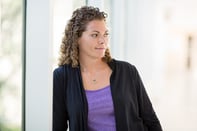Published on
A Bright Spot in the Zoom Gloom: Remote Dual Enrollment for Urban Students in COVID-19 Red Zones

This article is co-written with Nomar Pena, Genesis Bernabel and Vanessa McKelly—students in the dual enrollment program at Notre Dame Cristo Rey High School in the Spring 2021 term—and Kate Orbon, a graduate fellow and student in Community Engagement at Merrimack College for 2020-2021.
The 2020-21 school year was tough for high school juniors and seniors throughout the nation, and the impact of the year on future college enrollment so far has been negative.
To address the educational impacts of COVID-19, the federal government provided funds for the state of Massachusetts to launch dual enrollment classes as a partnership between high schools located in COVID red zones and local colleges and universities. These programs can provide a model for engaging high school students with the college experience, even if they do not fully embrace the online modality of the courses offered.
According to the Fall 2021 report of the National Student Clearinghouse, dual enrollment students showed the lowest decline of students enrolled in two- and four-year institutions, with an estimated dip of under 1%, compared to the overall decline of students at two-year public institutions (-14%) and the massive decline of Black (-33%) and Latinx students (-21%). These numbers are reflective of a breakdown in the relationship between the K-12 and higher education systems and a challenge to find new ways to bridge these gaps for our students most in need of access to higher education.
The surge in COVID cases this winter point to high schools being remote or hybrid again this spring, making the transition to college more difficult. Last year, high school seniors had trouble keeping pace with the college admissions cycle, and many of the rituals that helped anchor students to college admission—such as in person tours, SAT/ACT tests, meeting with counselors—became less common. Strategies such as dual enrollment classes, particularly if offered free of charge and at convenient times for students, can have a major impact on college admissions and enrollment.
At Merrimack College, we were lucky enough to have the chance to work with students in Lawrence/Methuen and Boston last year. Program participants took online synchronous classes in human development, criminology, health careers, and diversity, social justice & ethics. In the spring 2021 term, 96% of students completed the class they started, earning a total of 248 credits with an average GPA of 3.6 out of a possible 4.0.
Student expectations for college classes were changed by the program. Many students entered this experience believing that classes would be mostly lectures but learned otherwise.
One student wrote, “My vision of taking a college class was that it would be too overwhelming and scary, but after taking the class, it was the total opposite: I loved and enjoyed every moment of it, and I really appreciate all of Dr. Tannebaum’’s efforts in making the class so interesting and engaging.”
Another student commented, “My vision of a college class was very strict and just the teacher giving us a lecture. Instead, once this class started the teachers were very interactive with the students and made sure that we understood the subject well. It was an amazing experience.”
The classes also helped open student eyes to different majors and careers. Classes such as Tia Roy’s Introduction to Health Careers presented a new career option (and guest speaker from that field) each week in class.
One student wrote, “I was already looking into a career in the medical field. This course really opened my eyes towards learning more about the human brain, why people act the way they act and how exactly the brain’s development and health affects the way we behave. Now I am looking into becoming a neurologist and am actually taking a neuroscience program this summer.”
In addition, survey results showed that students made gains from the program:
- 86% of dual enrollment students reported that program participation increased their likelihood of attending a four-year college or university.
- 66% of students felt more confident about attending college based on their experience in the program.
- 91% agreed that they had enough support from their instructor and program staff to complete the class.
- 93% of students reported that the class gave them ideas for new careers they had not considered.
- 73% reported better time management as a result of the class
- 68% reported better self-advocacy skills through interacting with professors and teaching assistants.
The chance to take courses for free was a big draw for students, who viewed it as a unique opportunity to try out a college class. The courses also helped students think about future careers and majors without the pressure of paying for tuition and fees.
The classes also provided a way to get to know college instructors, who were found to be supportive and reasonable in their expectations. Students found that the instructors and the undergraduates who served as teaching assistants provided the support they needed to succeed in the class. Even while students reported they might prefer an in-person class, they learned to navigate the classwork and online assignments, and appreciated that faculty and support staff reached out to help.
While dual enrollment and remote college classes are by no means a panacea for the afflictions gripping college admissions nationwide, they point the way toward a more hopeful future.
With the continual impact of COVID-19 on urban students, remote dual enrollment should be made a permanent part of the strategies available to high schools and colleges to address the declining number of K-12 students headed for college enrollment.
Author Perspective: Administrator
Author Perspective: Student



